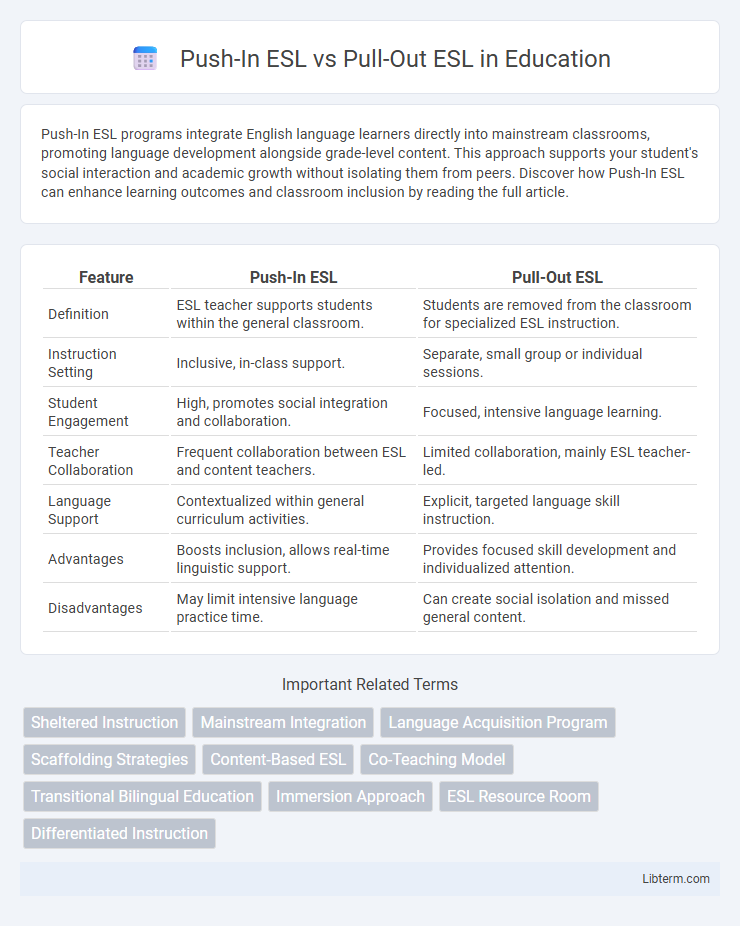Push-In ESL programs integrate English language learners directly into mainstream classrooms, promoting language development alongside grade-level content. This approach supports your student's social interaction and academic growth without isolating them from peers. Discover how Push-In ESL can enhance learning outcomes and classroom inclusion by reading the full article.
Table of Comparison
| Feature | Push-In ESL | Pull-Out ESL |
|---|---|---|
| Definition | ESL teacher supports students within the general classroom. | Students are removed from the classroom for specialized ESL instruction. |
| Instruction Setting | Inclusive, in-class support. | Separate, small group or individual sessions. |
| Student Engagement | High, promotes social integration and collaboration. | Focused, intensive language learning. |
| Teacher Collaboration | Frequent collaboration between ESL and content teachers. | Limited collaboration, mainly ESL teacher-led. |
| Language Support | Contextualized within general curriculum activities. | Explicit, targeted language skill instruction. |
| Advantages | Boosts inclusion, allows real-time linguistic support. | Provides focused skill development and individualized attention. |
| Disadvantages | May limit intensive language practice time. | Can create social isolation and missed general content. |
Introduction to Push-In and Pull-Out ESL Programs
Push-In ESL programs integrate English language learners (ELLs) directly into mainstream classrooms, allowing them to receive language support alongside grade-level content, which promotes social integration and continuous academic engagement. Pull-Out ESL programs remove ELLs from their regular classrooms for specialized language instruction, focusing intensively on English acquisition in smaller groups to address specific linguistic needs. Both models aim to enhance English proficiency but differ in their instructional setting and interaction with general education content.
Defining Push-In ESL: Key Features
Push-In ESL involves integrating English language learners (ELLs) directly into mainstream classrooms, where ESL instructors provide specialized language support without removing students from their general education setting. This model emphasizes collaboration between ESL and content area teachers, allowing real-time language reinforcement alongside academic instruction. Key features include targeted language scaffolding, differentiated instruction, and fostering inclusive learning environments to enhance both language acquisition and content mastery.
Understanding Pull-Out ESL: Core Concepts
Pull-Out ESL programs provide targeted language instruction by removing English learners from mainstream classrooms for specialized support, focusing on individualized skill development in reading, writing, and speaking. This approach allows ESL educators to tailor lessons based on students' proficiency levels and specific linguistic needs, enhancing comprehension and academic achievement. Despite potential challenges in integration, Pull-Out ESL remains effective for concentrated language acquisition and targeted intervention.
Benefits of Push-In ESL Instruction
Push-In ESL instruction enhances language acquisition by integrating English learners directly into mainstream classrooms, promoting real-time language practice and social interaction. This method supports collaborative learning, allowing students to apply ESL skills across multiple subjects while receiving targeted support. Research indicates that push-in models improve both academic outcomes and English proficiency by fostering an inclusive environment and reducing stigmatization.
Advantages of Pull-Out ESL Instruction
Pull-Out ESL instruction offers individualized language support by removing students from their general education classrooms, allowing targeted focus on specific language challenges. This approach enables tailored lesson plans that address distinct linguistic needs, promoting faster language acquisition and improved academic performance. Small group or one-on-one settings foster a supportive learning environment, increasing student confidence and participation.
Challenges of the Push-In Model
The push-in ESL model often faces challenges such as limited individualized attention, as ESL students remain in mainstream classrooms with diverse proficiency levels. Teachers may struggle to balance curriculum standards with language support without specialized training, leading to inconsistent instructional quality. Constraints in time and resources can hinder effective collaboration between ESL specialists and content teachers, reducing the efficacy of push-in interventions.
Limitations of the Pull-Out Model
The Pull-Out ESL model often limits students' exposure to mainstream academic subjects, causing segregation from native-speaking peers and potential stigmatization. This approach can interrupt continuous learning by removing students from core content classes, resulting in missed instructional time and gaps in subject mastery. Moreover, inconsistent scheduling and reduced classroom interaction hinder language development and academic integration.
Factors Affecting ESL Program Choice
Factors affecting the choice between Push-In ESL and Pull-Out ESL programs include student language proficiency levels, teacher availability, and classroom dynamics. Push-In ESL supports integration by allowing English learners to receive assistance within the mainstream classroom, promoting social interaction and content learning simultaneously. Pull-Out ESL provides intensive, focused language instruction outside the regular classroom, which can benefit students needing targeted skill development but may reduce exposure to grade-level content.
Best Practices for Effective ESL Support
Push-In ESL programs integrate language support within mainstream classrooms, allowing ESL students to receive assistance without missing core content, which promotes inclusion and real-time language development. Pull-Out ESL programs provide targeted, small-group or one-on-one instruction outside the general classroom, focusing on specific language skills that require intense support and customization. Effective ESL support combines push-in methods for consistent language exposure with strategic pull-out sessions, ensuring both academic content mastery and focused language skill enhancement.
Conclusion: Choosing Between Push-In and Pull-Out ESL
Choosing between Push-In ESL and Pull-Out ESL depends on student needs and instructional goals; Push-In ESL integrates language support within the mainstream classroom, promoting inclusive learning and real-time language practice, whereas Pull-Out ESL provides targeted, individualized instruction outside the general classroom, allowing for focused skill development. Data from the National Center for Education Statistics indicate that students in Push-In programs often experience higher engagement and social integration, while Pull-Out models can accelerate language proficiency for those requiring intensive support. Effective ESL programs tailor the approach to the learner's language level, academic requirements, and personal preferences to maximize language acquisition and academic success.
Push-In ESL Infographic

 libterm.com
libterm.com